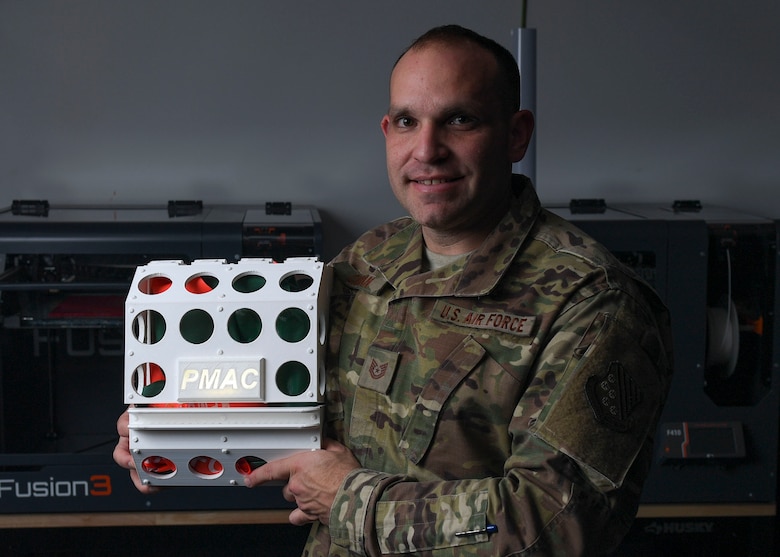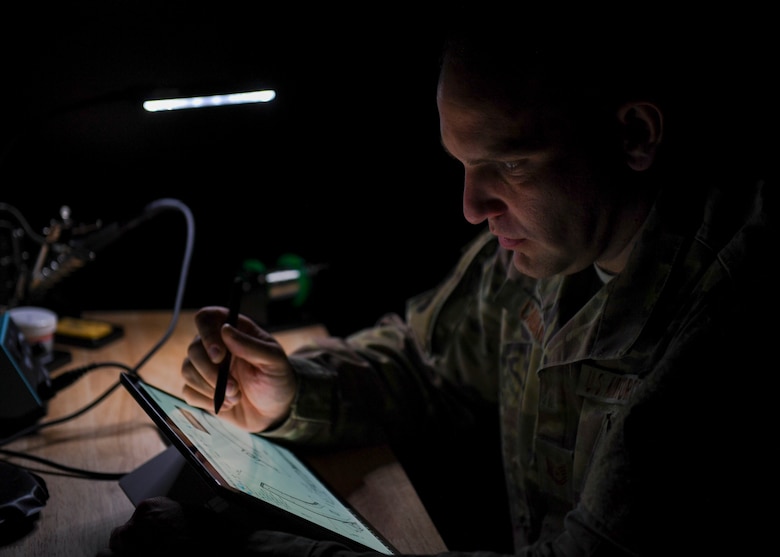As the Air Force faces continued fiscal constraints, the need for Airmen to be innovative in identifying and solving mission shortfalls keeps growing.
For the 1st Fighter Wing Innovation Cell at Joint Base Langley-Eustis, Virginia, adopting Tech. Sgt. Daniel Caban's new concept for F-22 Raptor intake covers came as an improvement to a standing maintenance practice.
Caban, a 1st Aircraft Maintenance Squadron crew chief, created Portable Magnetic Aircraft Covers, also known as PMAC. The PMAC system is made of polymagnets and Nomex IIIA fibers, which can be folded and packed into a small compartment on the aircraft. The new design eliminates the need for the current Dash 21 gear, which requires separate shipping to the aircraft's predisposed location due to their size.
Caban, who studied drafting in college, explained he chose these materials to construct PMAC because of Nomex IIIA's electrostatic and hydrophobic properties, which allows the material to breathe while withstanding water.
The specialized magnets adhere to rigid structures without interrupting sensitive electronic components nearby, and mitigates damage due to wear on the jet's coating.
"The hopes for my concept is to minimize the need for Dash 21 movement since we have these new protective covers available any time," Caban said. "(PMAC) will help execute the mission as they require less to maintain, so we're designing the new ones with better material that will last longer and protect against the elements a lot better."
The current Dash 21 sets are made up of foam pads, which measure at 13.1 cubic feet and cost $11,000 each. Each jet requires three Dash 21 sets to ensure the intakes and sensitive openings are protected at each location the pilot lands during missions.
Caban's new design measures at 567 cubic inches and is slated to have a production cost that is less than half of the Dash 21 gear production cost.
The compact size could prove to be cost effective in terms of shipping since the set will travel with the jet, allowing aircraft maintainers at various locations to apply the covers anytime they are needed.
"This idea really has the potential to revolutionize the way we do things," said Maj. Brian Pascuzzi, 1st Fighter Wing Plans and Programs chief of wing plans. "When you look at the deployment costs and the readiness enhancement that's possible with this idea, that's really where you get the bang for your buck as far as PMAC goes.
"This is really what the innovation cell is all about: finding ways to sharpen lethality and enhance readiness to get the mission done in a more innovative way."
Pascuzzi, who also served as the 1st FW Innovation Cell chief since its establishment in March, credits Caban's PMAC as being one of the first ideas presented during a pitch session to the innovation board, which included the wing commander, the maintenance group commander and other senior leaders.
"There was immediately a lot of buzz and a lot of excitement after (Caban) presented his idea," Pascuzzi said. "He came into the room carrying a large duffle bag containing a full set of Dash 21 gear, and contrasted its size by displaying his functioning prototype next to it. People's eyes kind of went wide like, 'Wow!'"
Since the initial presentation, Pascuzzi and other innovation cell members have worked closely with Caban to create an innovative pathway that has led him to the first phase of production, where he partnered with a local business to produce a PMAC prototype made at no cost to the unit.
Fighter wing leaders and innovation cell members are discussing PMAC's potential impact on all aircraft.
"Right now we're talking about cost savings for all F-22 (Raptors), but we're also looking at applicability to other aircraft not only in the Air Force inventory, but possibly (Department of Defense) wide," Pascuzzi continued. "I wouldn't be surprised if in a few years you go on vacation and you see commercial airlines using portable magnetic covers."
According to Pascuzzi, 1st FW leaders are thrilled to support their Airmen and the potential in Caban's creation has them looking forward to hearing about innovative ideas from all JB Langley-Eustis members.
"I hope that other Airmen are inspired when they see (Caban's) success with his concept in such a short amount of time," Pascuzzi added. "We know innovative ideas are out there, and we need our (service members) to know that we are here to guide them down that creative path."
Caban and innovation cell leaders are hopeful that PMAC will be selected as a finalist for the 2020 Spark Tank Competition during the Air Force Association conference in Orlando, Florida.

Tech. Sgt. Daniel Caban, 1st Aircraft Maintenance Squadron crew chief, poses with his Portable Magnetic Aircraft Covers prototype in the 1st Fighter Wing Innovation Cell Lab at Joint Base Langley-Eustis, Va., Nov. 5, 2019. Caban utilized the lab's tools to design a 3-D print replica of the F-22 Raptor compartment that can house the PMAC system for maintainers to use at various locations. (U.S. Air Force photo by Senior Airman Monica Roybal)

Tech. Sgt. Daniel Caban, 1st Aircraft Maintenance Squadron crew chief, secures his invention, Portable Magnetic Aircraft Covers, to an F-22 Raptor intake at Joint Base Langley-Eustis, Va., Oct. 23, 2019. PMAC is made of polymagnets and Nomex IIIA fibers that can be folded and packed into a small compartment on the aircraft, eliminating the need for the current Dash 21 gear that requires separate shipping due to its size. (U.S. Air Force photo by Senior Airman Monica Roybal)

Tech. Sgt. Daniel Caban, 1st Aircraft Maintenance Squadron crew chief, creates a draft in the 1st Fighter Wing Innovation Cell Lab at Joint Base Langley-Eustis, Va., Nov. 5, 2019. Caban used his knowledge in drafting, materials and methods to design the Portable Magnetic Aircraft Covers system for F-22 Raptors. (U.S. Air Force photo by Senior Airman Monica Roybal)






